Pathophysiology and Pharmacology
VerifiedAdded on 2023/04/21
|12
|3402
|359
AI Summary
This document discusses the pathophysiology and pharmacology related to a case patient with bilateral pneumonia. It explores the symptoms experienced by the patient and the medications prescribed for treatment.
Contribute Materials
Your contribution can guide someone’s learning journey. Share your
documents today.
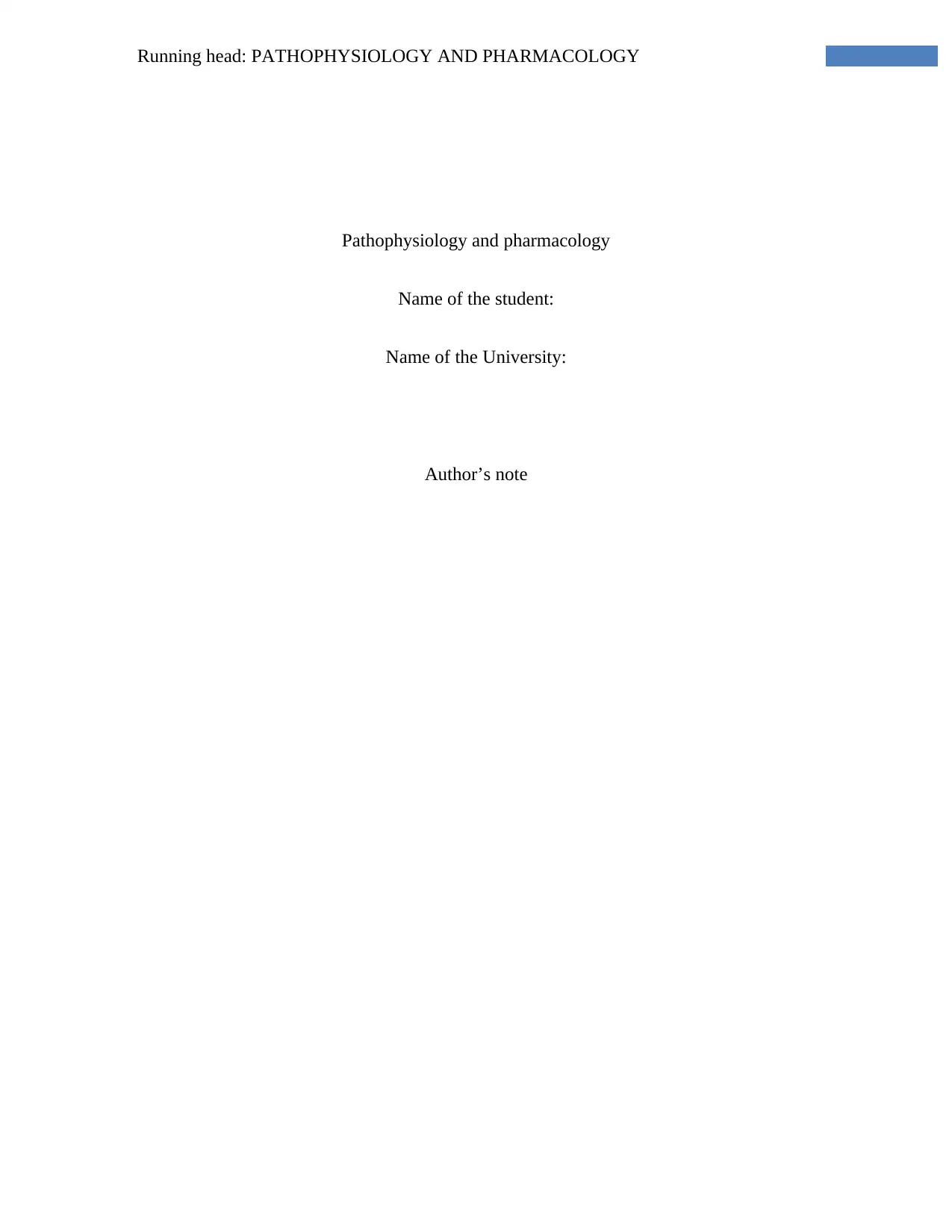
Running head: PATHOPHYSIOLOGY AND PHARMACOLOGY
Pathophysiology and pharmacology
Name of the student:
Name of the University:
Author’s note
Pathophysiology and pharmacology
Name of the student:
Name of the University:
Author’s note
Secure Best Marks with AI Grader
Need help grading? Try our AI Grader for instant feedback on your assignments.
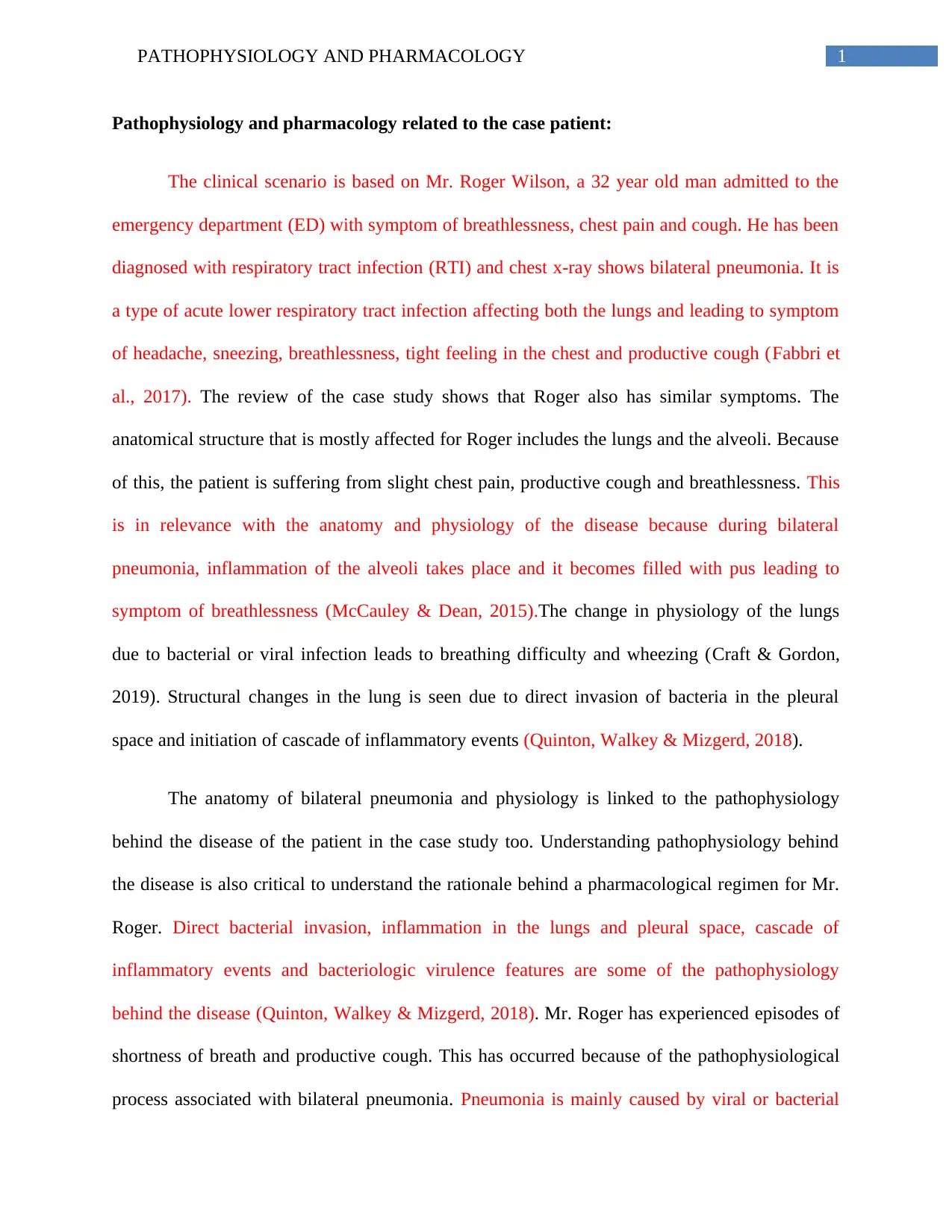
1PATHOPHYSIOLOGY AND PHARMACOLOGY
Pathophysiology and pharmacology related to the case patient:
The clinical scenario is based on Mr. Roger Wilson, a 32 year old man admitted to the
emergency department (ED) with symptom of breathlessness, chest pain and cough. He has been
diagnosed with respiratory tract infection (RTI) and chest x-ray shows bilateral pneumonia. It is
a type of acute lower respiratory tract infection affecting both the lungs and leading to symptom
of headache, sneezing, breathlessness, tight feeling in the chest and productive cough (Fabbri et
al., 2017). The review of the case study shows that Roger also has similar symptoms. The
anatomical structure that is mostly affected for Roger includes the lungs and the alveoli. Because
of this, the patient is suffering from slight chest pain, productive cough and breathlessness. This
is in relevance with the anatomy and physiology of the disease because during bilateral
pneumonia, inflammation of the alveoli takes place and it becomes filled with pus leading to
symptom of breathlessness (McCauley & Dean, 2015).The change in physiology of the lungs
due to bacterial or viral infection leads to breathing difficulty and wheezing (Craft & Gordon,
2019). Structural changes in the lung is seen due to direct invasion of bacteria in the pleural
space and initiation of cascade of inflammatory events (Quinton, Walkey & Mizgerd, 2018).
The anatomy of bilateral pneumonia and physiology is linked to the pathophysiology
behind the disease of the patient in the case study too. Understanding pathophysiology behind
the disease is also critical to understand the rationale behind a pharmacological regimen for Mr.
Roger. Direct bacterial invasion, inflammation in the lungs and pleural space, cascade of
inflammatory events and bacteriologic virulence features are some of the pathophysiology
behind the disease (Quinton, Walkey & Mizgerd, 2018). Mr. Roger has experienced episodes of
shortness of breath and productive cough. This has occurred because of the pathophysiological
process associated with bilateral pneumonia. Pneumonia is mainly caused by viral or bacterial
Pathophysiology and pharmacology related to the case patient:
The clinical scenario is based on Mr. Roger Wilson, a 32 year old man admitted to the
emergency department (ED) with symptom of breathlessness, chest pain and cough. He has been
diagnosed with respiratory tract infection (RTI) and chest x-ray shows bilateral pneumonia. It is
a type of acute lower respiratory tract infection affecting both the lungs and leading to symptom
of headache, sneezing, breathlessness, tight feeling in the chest and productive cough (Fabbri et
al., 2017). The review of the case study shows that Roger also has similar symptoms. The
anatomical structure that is mostly affected for Roger includes the lungs and the alveoli. Because
of this, the patient is suffering from slight chest pain, productive cough and breathlessness. This
is in relevance with the anatomy and physiology of the disease because during bilateral
pneumonia, inflammation of the alveoli takes place and it becomes filled with pus leading to
symptom of breathlessness (McCauley & Dean, 2015).The change in physiology of the lungs
due to bacterial or viral infection leads to breathing difficulty and wheezing (Craft & Gordon,
2019). Structural changes in the lung is seen due to direct invasion of bacteria in the pleural
space and initiation of cascade of inflammatory events (Quinton, Walkey & Mizgerd, 2018).
The anatomy of bilateral pneumonia and physiology is linked to the pathophysiology
behind the disease of the patient in the case study too. Understanding pathophysiology behind
the disease is also critical to understand the rationale behind a pharmacological regimen for Mr.
Roger. Direct bacterial invasion, inflammation in the lungs and pleural space, cascade of
inflammatory events and bacteriologic virulence features are some of the pathophysiology
behind the disease (Quinton, Walkey & Mizgerd, 2018). Mr. Roger has experienced episodes of
shortness of breath and productive cough. This has occurred because of the pathophysiological
process associated with bilateral pneumonia. Pneumonia is mainly caused by viral or bacterial
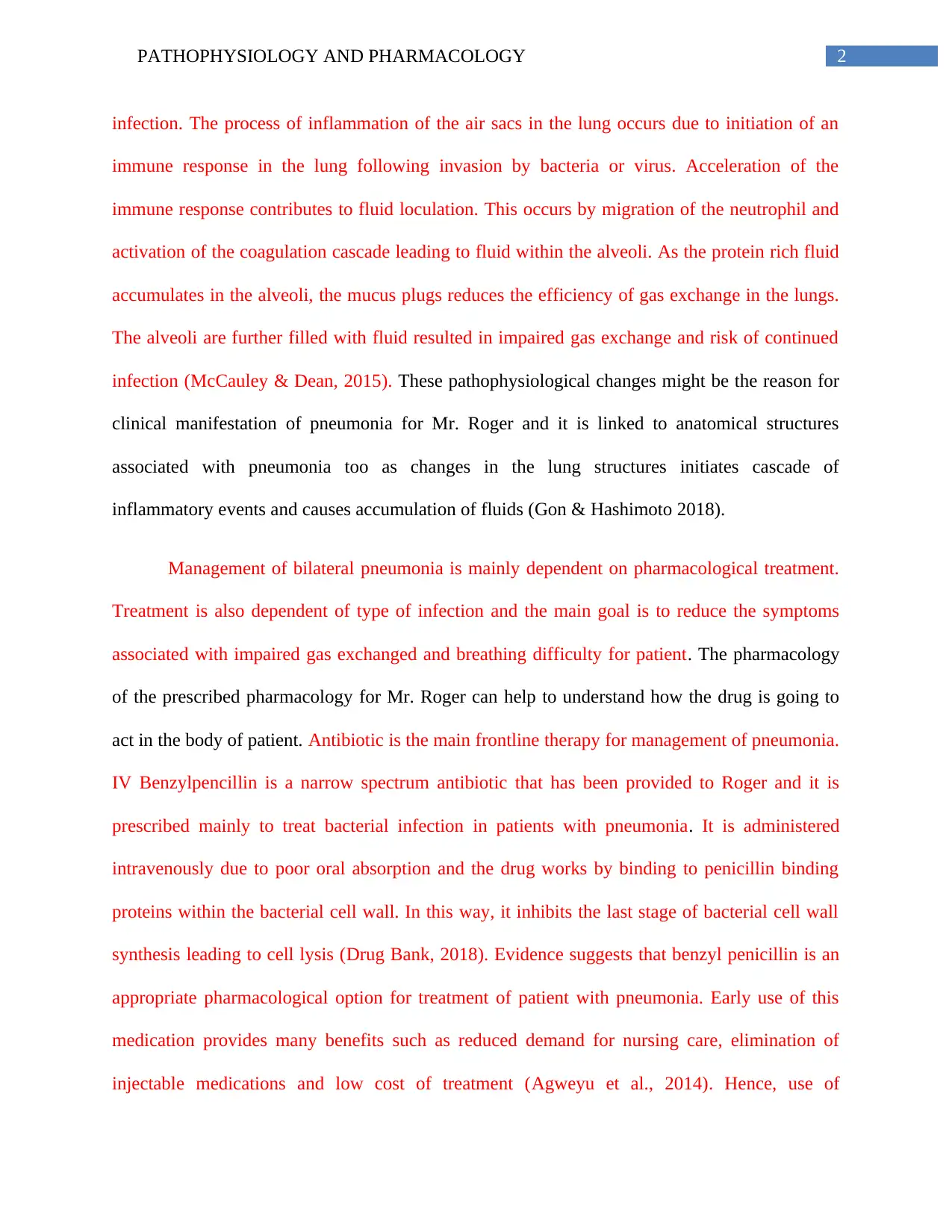
2PATHOPHYSIOLOGY AND PHARMACOLOGY
infection. The process of inflammation of the air sacs in the lung occurs due to initiation of an
immune response in the lung following invasion by bacteria or virus. Acceleration of the
immune response contributes to fluid loculation. This occurs by migration of the neutrophil and
activation of the coagulation cascade leading to fluid within the alveoli. As the protein rich fluid
accumulates in the alveoli, the mucus plugs reduces the efficiency of gas exchange in the lungs.
The alveoli are further filled with fluid resulted in impaired gas exchange and risk of continued
infection (McCauley & Dean, 2015). These pathophysiological changes might be the reason for
clinical manifestation of pneumonia for Mr. Roger and it is linked to anatomical structures
associated with pneumonia too as changes in the lung structures initiates cascade of
inflammatory events and causes accumulation of fluids (Gon & Hashimoto 2018).
Management of bilateral pneumonia is mainly dependent on pharmacological treatment.
Treatment is also dependent of type of infection and the main goal is to reduce the symptoms
associated with impaired gas exchanged and breathing difficulty for patient. The pharmacology
of the prescribed pharmacology for Mr. Roger can help to understand how the drug is going to
act in the body of patient. Antibiotic is the main frontline therapy for management of pneumonia.
IV Benzylpencillin is a narrow spectrum antibiotic that has been provided to Roger and it is
prescribed mainly to treat bacterial infection in patients with pneumonia. It is administered
intravenously due to poor oral absorption and the drug works by binding to penicillin binding
proteins within the bacterial cell wall. In this way, it inhibits the last stage of bacterial cell wall
synthesis leading to cell lysis (Drug Bank, 2018). Evidence suggests that benzyl penicillin is an
appropriate pharmacological option for treatment of patient with pneumonia. Early use of this
medication provides many benefits such as reduced demand for nursing care, elimination of
injectable medications and low cost of treatment (Agweyu et al., 2014). Hence, use of
infection. The process of inflammation of the air sacs in the lung occurs due to initiation of an
immune response in the lung following invasion by bacteria or virus. Acceleration of the
immune response contributes to fluid loculation. This occurs by migration of the neutrophil and
activation of the coagulation cascade leading to fluid within the alveoli. As the protein rich fluid
accumulates in the alveoli, the mucus plugs reduces the efficiency of gas exchange in the lungs.
The alveoli are further filled with fluid resulted in impaired gas exchange and risk of continued
infection (McCauley & Dean, 2015). These pathophysiological changes might be the reason for
clinical manifestation of pneumonia for Mr. Roger and it is linked to anatomical structures
associated with pneumonia too as changes in the lung structures initiates cascade of
inflammatory events and causes accumulation of fluids (Gon & Hashimoto 2018).
Management of bilateral pneumonia is mainly dependent on pharmacological treatment.
Treatment is also dependent of type of infection and the main goal is to reduce the symptoms
associated with impaired gas exchanged and breathing difficulty for patient. The pharmacology
of the prescribed pharmacology for Mr. Roger can help to understand how the drug is going to
act in the body of patient. Antibiotic is the main frontline therapy for management of pneumonia.
IV Benzylpencillin is a narrow spectrum antibiotic that has been provided to Roger and it is
prescribed mainly to treat bacterial infection in patients with pneumonia. It is administered
intravenously due to poor oral absorption and the drug works by binding to penicillin binding
proteins within the bacterial cell wall. In this way, it inhibits the last stage of bacterial cell wall
synthesis leading to cell lysis (Drug Bank, 2018). Evidence suggests that benzyl penicillin is an
appropriate pharmacological option for treatment of patient with pneumonia. Early use of this
medication provides many benefits such as reduced demand for nursing care, elimination of
injectable medications and low cost of treatment (Agweyu et al., 2014). Hence, use of

3PATHOPHYSIOLOGY AND PHARMACOLOGY
Benzylpenicillin can hasten recovery by reducing progression of infection and preventing
complications for Mr. Roger.
Another medication prescribed to Roger for first day includes Doxycyline. The main
rationale behind giving this medication is that it also works to prevent growth of bacteria and
thus treat infection. It belongs to the drug class tetracycline antibiotics and it is used to treat
different types of bacterial infection. It also has similar course of action like that of
benzylpencillin and it inhibits protein synthesis by binding to the 30S ribosomal unit. This
results in inhibition of bactetial growth and consequently improvement in symptoms of patient
(Nightingale & Bishai, 2016). In response to history of mild asthma, Mr. Roger takes Salbutamol
via metered dose inhaler (MDI). Salbutamol is a short acting beta2adgrenergic receptor agonist
used in the treatment of asthma. Evidence suggests that β2‐Adrenoceptor agonists and
glucocorticoids are the most effective pharmacological options for the treatment of airway
inflammation. It is part of first line therapy for asthma. β2‐Adrenoceptor agonists are most vital
drug class for the treatment of asthma. Short acting preparations like salbutamol is provided on
need basis and long-acting preparation in combination with glucocorticoid is used for long-term
treatment (Amrani & Bradding 2017). This pharmacological treatment is linked to treatment of
bronchocontriction for Mr. Roger because this class of drug has bronchodilator effect and they
play a role in relieving breathlessness.
Explanation of the three symptoms in the cases study:
The three dominant symptoms of bilateral pneumonia that has been found in Mr. Roger
includes breathlessness, productive cough and chest pain. These three symptoms are some of the
clinical manifestation of pneumonia too. These three symptoms are connected with the
Benzylpenicillin can hasten recovery by reducing progression of infection and preventing
complications for Mr. Roger.
Another medication prescribed to Roger for first day includes Doxycyline. The main
rationale behind giving this medication is that it also works to prevent growth of bacteria and
thus treat infection. It belongs to the drug class tetracycline antibiotics and it is used to treat
different types of bacterial infection. It also has similar course of action like that of
benzylpencillin and it inhibits protein synthesis by binding to the 30S ribosomal unit. This
results in inhibition of bactetial growth and consequently improvement in symptoms of patient
(Nightingale & Bishai, 2016). In response to history of mild asthma, Mr. Roger takes Salbutamol
via metered dose inhaler (MDI). Salbutamol is a short acting beta2adgrenergic receptor agonist
used in the treatment of asthma. Evidence suggests that β2‐Adrenoceptor agonists and
glucocorticoids are the most effective pharmacological options for the treatment of airway
inflammation. It is part of first line therapy for asthma. β2‐Adrenoceptor agonists are most vital
drug class for the treatment of asthma. Short acting preparations like salbutamol is provided on
need basis and long-acting preparation in combination with glucocorticoid is used for long-term
treatment (Amrani & Bradding 2017). This pharmacological treatment is linked to treatment of
bronchocontriction for Mr. Roger because this class of drug has bronchodilator effect and they
play a role in relieving breathlessness.
Explanation of the three symptoms in the cases study:
The three dominant symptoms of bilateral pneumonia that has been found in Mr. Roger
includes breathlessness, productive cough and chest pain. These three symptoms are some of the
clinical manifestation of pneumonia too. These three symptoms are connected with the
Secure Best Marks with AI Grader
Need help grading? Try our AI Grader for instant feedback on your assignments.
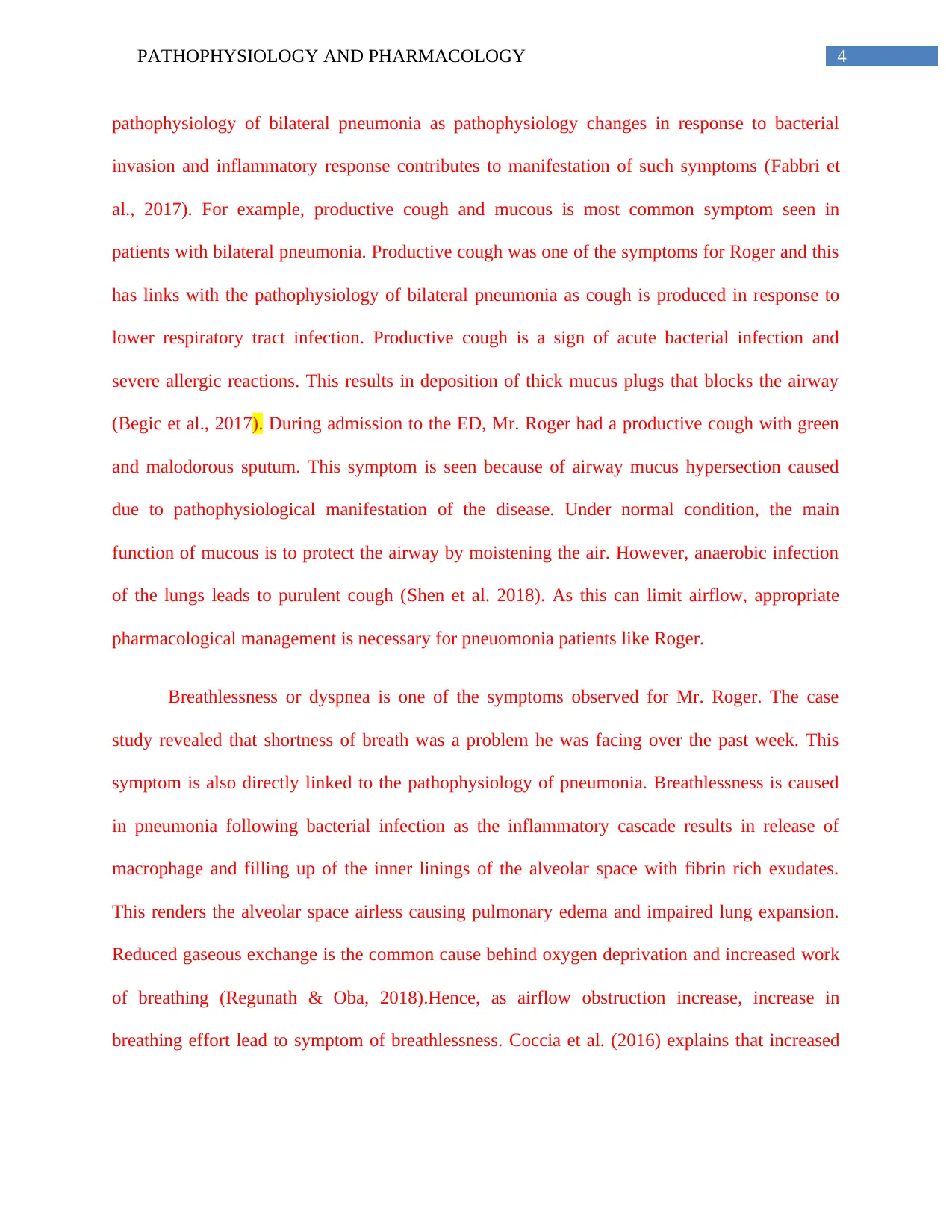
4PATHOPHYSIOLOGY AND PHARMACOLOGY
pathophysiology of bilateral pneumonia as pathophysiology changes in response to bacterial
invasion and inflammatory response contributes to manifestation of such symptoms (Fabbri et
al., 2017). For example, productive cough and mucous is most common symptom seen in
patients with bilateral pneumonia. Productive cough was one of the symptoms for Roger and this
has links with the pathophysiology of bilateral pneumonia as cough is produced in response to
lower respiratory tract infection. Productive cough is a sign of acute bacterial infection and
severe allergic reactions. This results in deposition of thick mucus plugs that blocks the airway
(Begic et al., 2017). During admission to the ED, Mr. Roger had a productive cough with green
and malodorous sputum. This symptom is seen because of airway mucus hypersection caused
due to pathophysiological manifestation of the disease. Under normal condition, the main
function of mucous is to protect the airway by moistening the air. However, anaerobic infection
of the lungs leads to purulent cough (Shen et al. 2018). As this can limit airflow, appropriate
pharmacological management is necessary for pneuomonia patients like Roger.
Breathlessness or dyspnea is one of the symptoms observed for Mr. Roger. The case
study revealed that shortness of breath was a problem he was facing over the past week. This
symptom is also directly linked to the pathophysiology of pneumonia. Breathlessness is caused
in pneumonia following bacterial infection as the inflammatory cascade results in release of
macrophage and filling up of the inner linings of the alveolar space with fibrin rich exudates.
This renders the alveolar space airless causing pulmonary edema and impaired lung expansion.
Reduced gaseous exchange is the common cause behind oxygen deprivation and increased work
of breathing (Regunath & Oba, 2018).Hence, as airflow obstruction increase, increase in
breathing effort lead to symptom of breathlessness. Coccia et al. (2016) explains that increased
pathophysiology of bilateral pneumonia as pathophysiology changes in response to bacterial
invasion and inflammatory response contributes to manifestation of such symptoms (Fabbri et
al., 2017). For example, productive cough and mucous is most common symptom seen in
patients with bilateral pneumonia. Productive cough was one of the symptoms for Roger and this
has links with the pathophysiology of bilateral pneumonia as cough is produced in response to
lower respiratory tract infection. Productive cough is a sign of acute bacterial infection and
severe allergic reactions. This results in deposition of thick mucus plugs that blocks the airway
(Begic et al., 2017). During admission to the ED, Mr. Roger had a productive cough with green
and malodorous sputum. This symptom is seen because of airway mucus hypersection caused
due to pathophysiological manifestation of the disease. Under normal condition, the main
function of mucous is to protect the airway by moistening the air. However, anaerobic infection
of the lungs leads to purulent cough (Shen et al. 2018). As this can limit airflow, appropriate
pharmacological management is necessary for pneuomonia patients like Roger.
Breathlessness or dyspnea is one of the symptoms observed for Mr. Roger. The case
study revealed that shortness of breath was a problem he was facing over the past week. This
symptom is also directly linked to the pathophysiology of pneumonia. Breathlessness is caused
in pneumonia following bacterial infection as the inflammatory cascade results in release of
macrophage and filling up of the inner linings of the alveolar space with fibrin rich exudates.
This renders the alveolar space airless causing pulmonary edema and impaired lung expansion.
Reduced gaseous exchange is the common cause behind oxygen deprivation and increased work
of breathing (Regunath & Oba, 2018).Hence, as airflow obstruction increase, increase in
breathing effort lead to symptom of breathlessness. Coccia et al. (2016) explains that increased
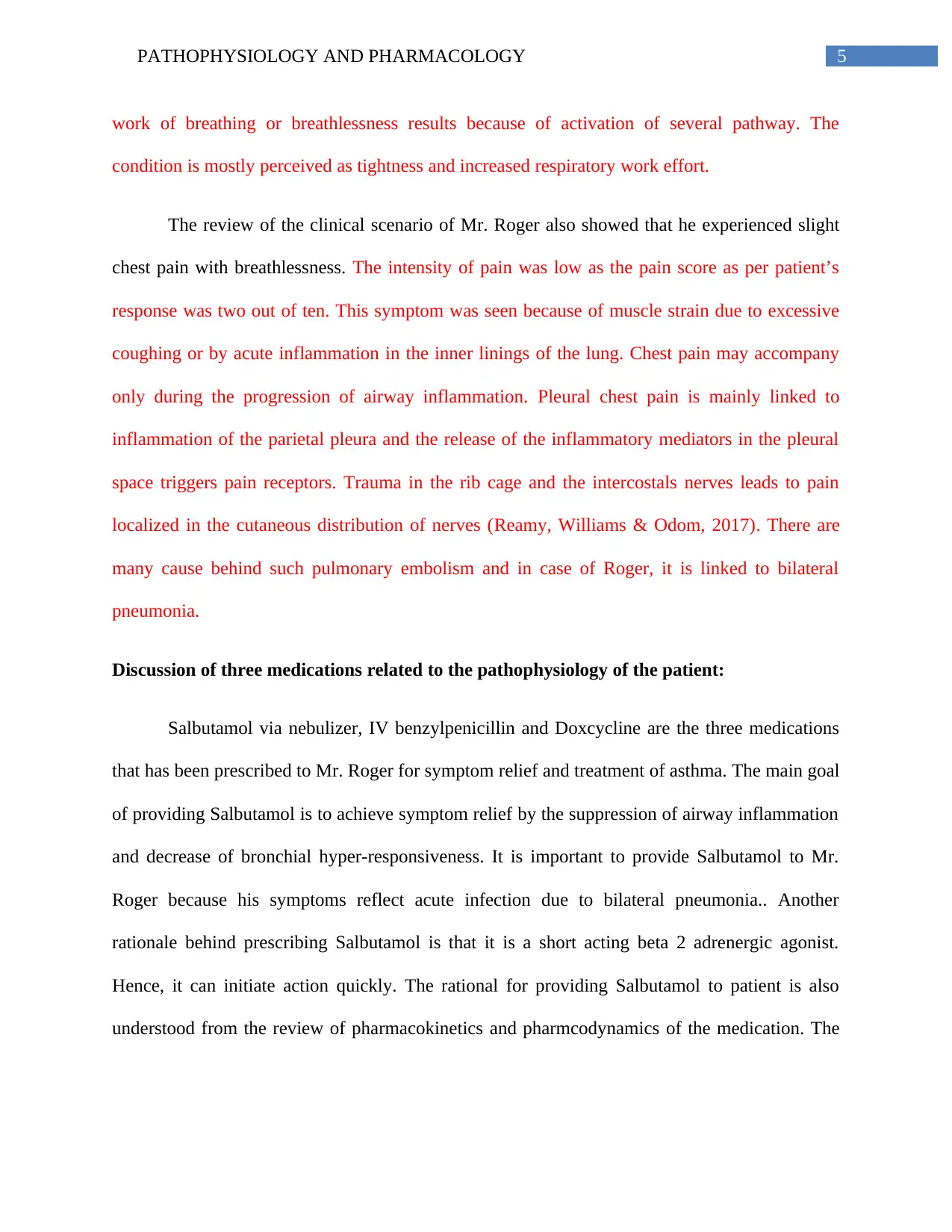
5PATHOPHYSIOLOGY AND PHARMACOLOGY
work of breathing or breathlessness results because of activation of several pathway. The
condition is mostly perceived as tightness and increased respiratory work effort.
The review of the clinical scenario of Mr. Roger also showed that he experienced slight
chest pain with breathlessness. The intensity of pain was low as the pain score as per patient’s
response was two out of ten. This symptom was seen because of muscle strain due to excessive
coughing or by acute inflammation in the inner linings of the lung. Chest pain may accompany
only during the progression of airway inflammation. Pleural chest pain is mainly linked to
inflammation of the parietal pleura and the release of the inflammatory mediators in the pleural
space triggers pain receptors. Trauma in the rib cage and the intercostals nerves leads to pain
localized in the cutaneous distribution of nerves (Reamy, Williams & Odom, 2017). There are
many cause behind such pulmonary embolism and in case of Roger, it is linked to bilateral
pneumonia.
Discussion of three medications related to the pathophysiology of the patient:
Salbutamol via nebulizer, IV benzylpenicillin and Doxcycline are the three medications
that has been prescribed to Mr. Roger for symptom relief and treatment of asthma. The main goal
of providing Salbutamol is to achieve symptom relief by the suppression of airway inflammation
and decrease of bronchial hyper-responsiveness. It is important to provide Salbutamol to Mr.
Roger because his symptoms reflect acute infection due to bilateral pneumonia.. Another
rationale behind prescribing Salbutamol is that it is a short acting beta 2 adrenergic agonist.
Hence, it can initiate action quickly. The rational for providing Salbutamol to patient is also
understood from the review of pharmacokinetics and pharmcodynamics of the medication. The
work of breathing or breathlessness results because of activation of several pathway. The
condition is mostly perceived as tightness and increased respiratory work effort.
The review of the clinical scenario of Mr. Roger also showed that he experienced slight
chest pain with breathlessness. The intensity of pain was low as the pain score as per patient’s
response was two out of ten. This symptom was seen because of muscle strain due to excessive
coughing or by acute inflammation in the inner linings of the lung. Chest pain may accompany
only during the progression of airway inflammation. Pleural chest pain is mainly linked to
inflammation of the parietal pleura and the release of the inflammatory mediators in the pleural
space triggers pain receptors. Trauma in the rib cage and the intercostals nerves leads to pain
localized in the cutaneous distribution of nerves (Reamy, Williams & Odom, 2017). There are
many cause behind such pulmonary embolism and in case of Roger, it is linked to bilateral
pneumonia.
Discussion of three medications related to the pathophysiology of the patient:
Salbutamol via nebulizer, IV benzylpenicillin and Doxcycline are the three medications
that has been prescribed to Mr. Roger for symptom relief and treatment of asthma. The main goal
of providing Salbutamol is to achieve symptom relief by the suppression of airway inflammation
and decrease of bronchial hyper-responsiveness. It is important to provide Salbutamol to Mr.
Roger because his symptoms reflect acute infection due to bilateral pneumonia.. Another
rationale behind prescribing Salbutamol is that it is a short acting beta 2 adrenergic agonist.
Hence, it can initiate action quickly. The rational for providing Salbutamol to patient is also
understood from the review of pharmacokinetics and pharmcodynamics of the medication. The

6PATHOPHYSIOLOGY AND PHARMACOLOGY
understanding regarding absorption, distribution, metabolism and excretion (ADME) can give
idea regarding how quickly the medication can provide relief to Mr. Roger.
The review of the pharmacodynamics of Salbutamol can help to interpret the mechanism
of action of the drug. As it is a beta 2 beta 2 adrenergic agonist, it works by inducing
bronchodilator effect by activating adrenergic receptors. It initiates cascase of pathway leading to
AMP release and increase in calcium ion concention thus causing symptom relief (Neame et al.,
2015). In addition, the pharmacokinetics details the duration by which above mentioned action is
accomplished (Bryant & Knights, 2019). The half life of salbutamol is 4 to 6 hours. After
inhalation, the medication acts on bronchial smooth muscles and the concentration of the drug
lowers after 2-3 hours. After this. the drug is absorbed in the gut. The bronchodilatory effect of
the drug is seen at blood concentration of 5-20 ng/ml. The medication is mostly distributed to the
lungs as unmetabolised drugs and the rest is deposited in oropharynx. Although Salbutamol is
not metabolized in the lungs, however it is converted to salbutamol 4’-O-sulfate. Salbutamol and
its metabolites are excreted in the urine. Hence, elimination half life is 5.5 hours post inhaled or
oral administration. The renal clearance of the drug depends on mode of administration. After
oral administration, renal clearance takes place as 38ml/min and for intravenous administration,
it is 70 ml/min (Drug Bank 2018). This explains the pharmacokinetic properties of Salbutamol
and how quickly Salbutamol is going to provide relief to Mr. Roger. The prescribed drug is
linked to pathophysiology as it works to address bronchoconstriction occurring due to airway
inflammation for asthma patient.
The second medication that was prescribed to Mr. Roger included IV Benzylpenicillin.
As Mr. Roger was experiencing breathlessness and increased work of breathing, Benzylpenicillin
was prescribed to him to improve breathing. Benzylpenicillin is an antibiotic that is used to treat
understanding regarding absorption, distribution, metabolism and excretion (ADME) can give
idea regarding how quickly the medication can provide relief to Mr. Roger.
The review of the pharmacodynamics of Salbutamol can help to interpret the mechanism
of action of the drug. As it is a beta 2 beta 2 adrenergic agonist, it works by inducing
bronchodilator effect by activating adrenergic receptors. It initiates cascase of pathway leading to
AMP release and increase in calcium ion concention thus causing symptom relief (Neame et al.,
2015). In addition, the pharmacokinetics details the duration by which above mentioned action is
accomplished (Bryant & Knights, 2019). The half life of salbutamol is 4 to 6 hours. After
inhalation, the medication acts on bronchial smooth muscles and the concentration of the drug
lowers after 2-3 hours. After this. the drug is absorbed in the gut. The bronchodilatory effect of
the drug is seen at blood concentration of 5-20 ng/ml. The medication is mostly distributed to the
lungs as unmetabolised drugs and the rest is deposited in oropharynx. Although Salbutamol is
not metabolized in the lungs, however it is converted to salbutamol 4’-O-sulfate. Salbutamol and
its metabolites are excreted in the urine. Hence, elimination half life is 5.5 hours post inhaled or
oral administration. The renal clearance of the drug depends on mode of administration. After
oral administration, renal clearance takes place as 38ml/min and for intravenous administration,
it is 70 ml/min (Drug Bank 2018). This explains the pharmacokinetic properties of Salbutamol
and how quickly Salbutamol is going to provide relief to Mr. Roger. The prescribed drug is
linked to pathophysiology as it works to address bronchoconstriction occurring due to airway
inflammation for asthma patient.
The second medication that was prescribed to Mr. Roger included IV Benzylpenicillin.
As Mr. Roger was experiencing breathlessness and increased work of breathing, Benzylpenicillin
was prescribed to him to improve breathing. Benzylpenicillin is an antibiotic that is used to treat
Paraphrase This Document
Need a fresh take? Get an instant paraphrase of this document with our AI Paraphraser
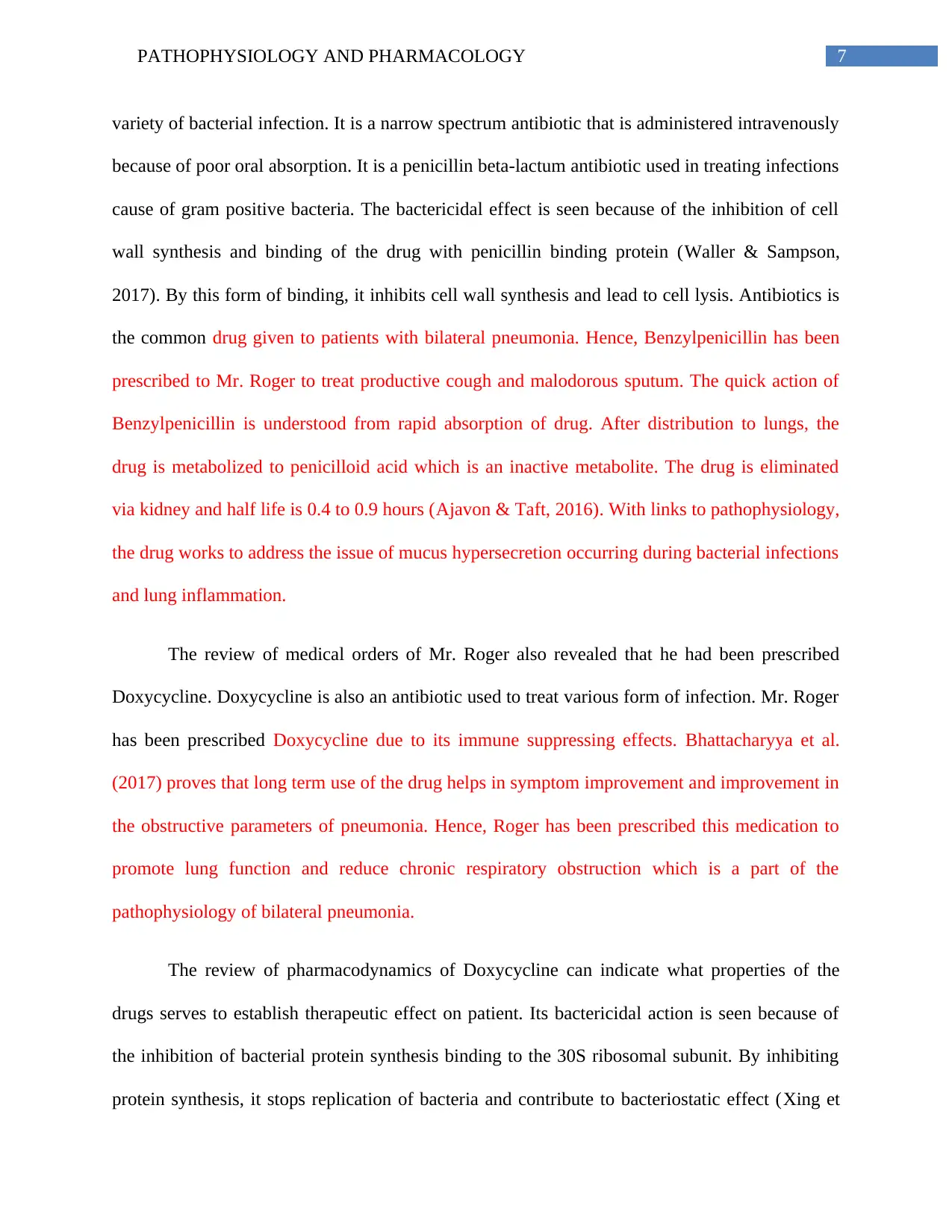
7PATHOPHYSIOLOGY AND PHARMACOLOGY
variety of bacterial infection. It is a narrow spectrum antibiotic that is administered intravenously
because of poor oral absorption. It is a penicillin beta-lactum antibiotic used in treating infections
cause of gram positive bacteria. The bactericidal effect is seen because of the inhibition of cell
wall synthesis and binding of the drug with penicillin binding protein (Waller & Sampson,
2017). By this form of binding, it inhibits cell wall synthesis and lead to cell lysis. Antibiotics is
the common drug given to patients with bilateral pneumonia. Hence, Benzylpenicillin has been
prescribed to Mr. Roger to treat productive cough and malodorous sputum. The quick action of
Benzylpenicillin is understood from rapid absorption of drug. After distribution to lungs, the
drug is metabolized to penicilloid acid which is an inactive metabolite. The drug is eliminated
via kidney and half life is 0.4 to 0.9 hours (Ajavon & Taft, 2016). With links to pathophysiology,
the drug works to address the issue of mucus hypersecretion occurring during bacterial infections
and lung inflammation.
The review of medical orders of Mr. Roger also revealed that he had been prescribed
Doxycycline. Doxycycline is also an antibiotic used to treat various form of infection. Mr. Roger
has been prescribed Doxycycline due to its immune suppressing effects. Bhattacharyya et al.
(2017) proves that long term use of the drug helps in symptom improvement and improvement in
the obstructive parameters of pneumonia. Hence, Roger has been prescribed this medication to
promote lung function and reduce chronic respiratory obstruction which is a part of the
pathophysiology of bilateral pneumonia.
The review of pharmacodynamics of Doxycycline can indicate what properties of the
drugs serves to establish therapeutic effect on patient. Its bactericidal action is seen because of
the inhibition of bacterial protein synthesis binding to the 30S ribosomal subunit. By inhibiting
protein synthesis, it stops replication of bacteria and contribute to bacteriostatic effect (Xing et
variety of bacterial infection. It is a narrow spectrum antibiotic that is administered intravenously
because of poor oral absorption. It is a penicillin beta-lactum antibiotic used in treating infections
cause of gram positive bacteria. The bactericidal effect is seen because of the inhibition of cell
wall synthesis and binding of the drug with penicillin binding protein (Waller & Sampson,
2017). By this form of binding, it inhibits cell wall synthesis and lead to cell lysis. Antibiotics is
the common drug given to patients with bilateral pneumonia. Hence, Benzylpenicillin has been
prescribed to Mr. Roger to treat productive cough and malodorous sputum. The quick action of
Benzylpenicillin is understood from rapid absorption of drug. After distribution to lungs, the
drug is metabolized to penicilloid acid which is an inactive metabolite. The drug is eliminated
via kidney and half life is 0.4 to 0.9 hours (Ajavon & Taft, 2016). With links to pathophysiology,
the drug works to address the issue of mucus hypersecretion occurring during bacterial infections
and lung inflammation.
The review of medical orders of Mr. Roger also revealed that he had been prescribed
Doxycycline. Doxycycline is also an antibiotic used to treat various form of infection. Mr. Roger
has been prescribed Doxycycline due to its immune suppressing effects. Bhattacharyya et al.
(2017) proves that long term use of the drug helps in symptom improvement and improvement in
the obstructive parameters of pneumonia. Hence, Roger has been prescribed this medication to
promote lung function and reduce chronic respiratory obstruction which is a part of the
pathophysiology of bilateral pneumonia.
The review of pharmacodynamics of Doxycycline can indicate what properties of the
drugs serves to establish therapeutic effect on patient. Its bactericidal action is seen because of
the inhibition of bacterial protein synthesis binding to the 30S ribosomal subunit. By inhibiting
protein synthesis, it stops replication of bacteria and contribute to bacteriostatic effect (Xing et
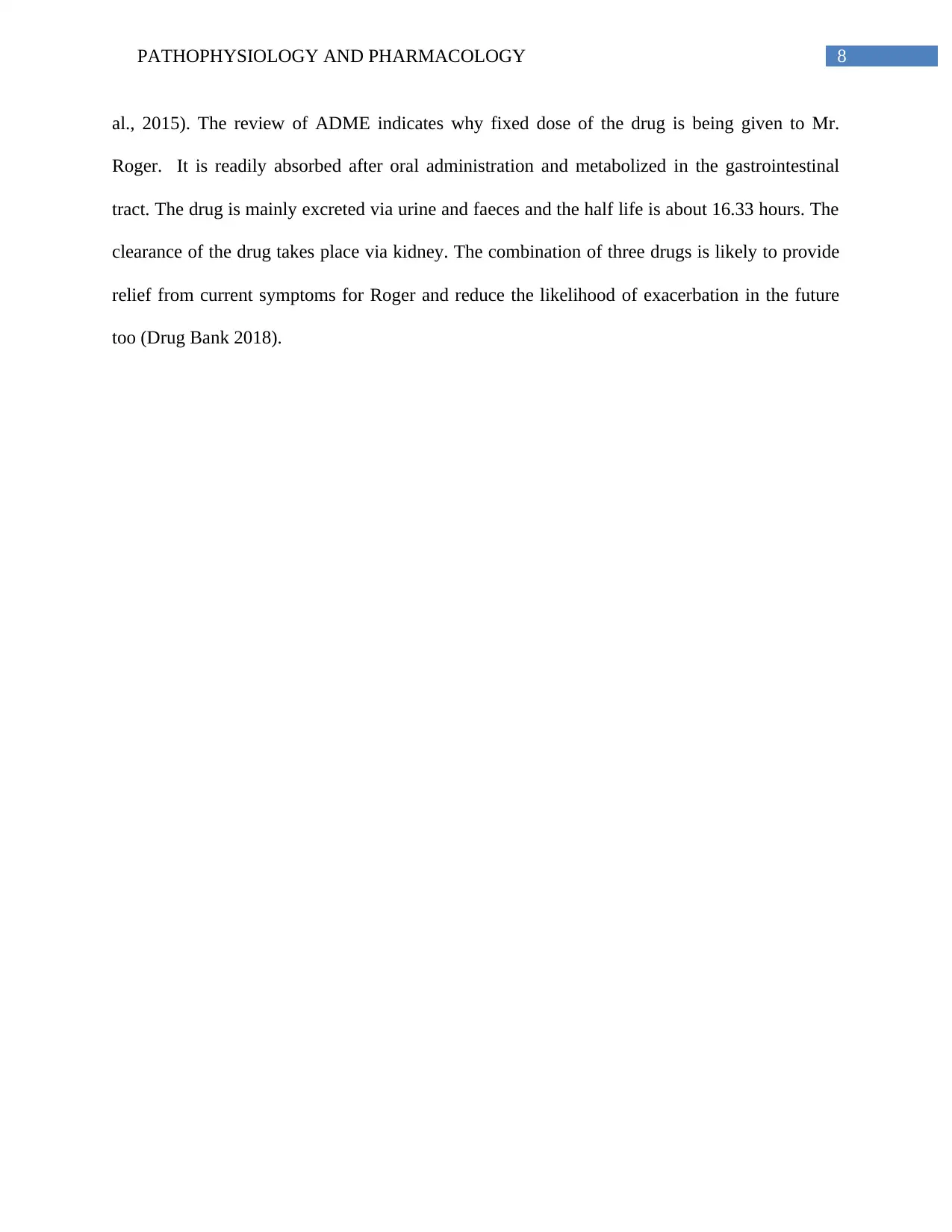
8PATHOPHYSIOLOGY AND PHARMACOLOGY
al., 2015). The review of ADME indicates why fixed dose of the drug is being given to Mr.
Roger. It is readily absorbed after oral administration and metabolized in the gastrointestinal
tract. The drug is mainly excreted via urine and faeces and the half life is about 16.33 hours. The
clearance of the drug takes place via kidney. The combination of three drugs is likely to provide
relief from current symptoms for Roger and reduce the likelihood of exacerbation in the future
too (Drug Bank 2018).
al., 2015). The review of ADME indicates why fixed dose of the drug is being given to Mr.
Roger. It is readily absorbed after oral administration and metabolized in the gastrointestinal
tract. The drug is mainly excreted via urine and faeces and the half life is about 16.33 hours. The
clearance of the drug takes place via kidney. The combination of three drugs is likely to provide
relief from current symptoms for Roger and reduce the likelihood of exacerbation in the future
too (Drug Bank 2018).
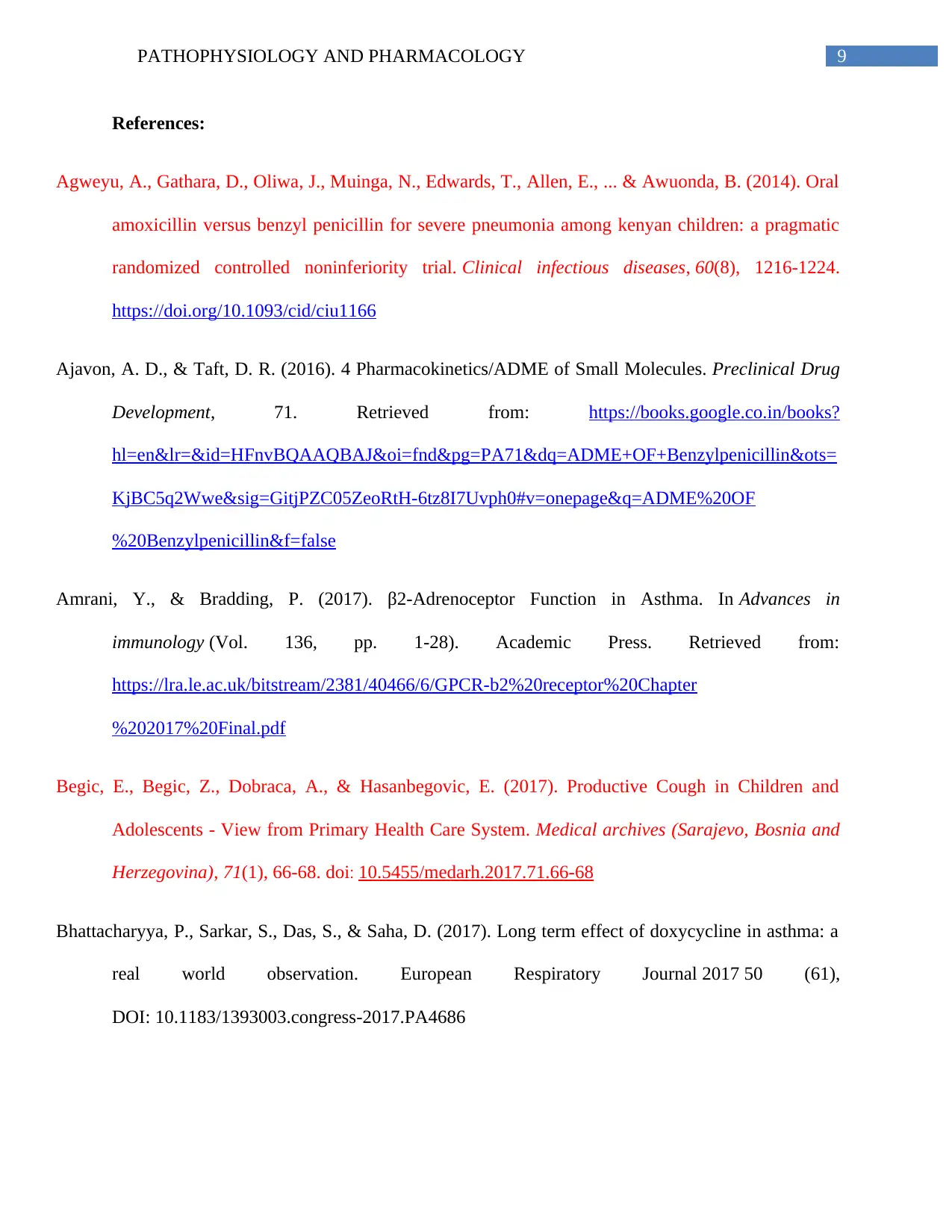
9PATHOPHYSIOLOGY AND PHARMACOLOGY
References:
Agweyu, A., Gathara, D., Oliwa, J., Muinga, N., Edwards, T., Allen, E., ... & Awuonda, B. (2014). Oral
amoxicillin versus benzyl penicillin for severe pneumonia among kenyan children: a pragmatic
randomized controlled noninferiority trial. Clinical infectious diseases, 60(8), 1216-1224.
https://doi.org/10.1093/cid/ciu1166
Ajavon, A. D., & Taft, D. R. (2016). 4 Pharmacokinetics/ADME of Small Molecules. Preclinical Drug
Development, 71. Retrieved from: https://books.google.co.in/books?
hl=en&lr=&id=HFnvBQAAQBAJ&oi=fnd&pg=PA71&dq=ADME+OF+Benzylpenicillin&ots=
KjBC5q2Wwe&sig=GitjPZC05ZeoRtH-6tz8I7Uvph0#v=onepage&q=ADME%20OF
%20Benzylpenicillin&f=false
Amrani, Y., & Bradding, P. (2017). β2-Adrenoceptor Function in Asthma. In Advances in
immunology (Vol. 136, pp. 1-28). Academic Press. Retrieved from:
https://lra.le.ac.uk/bitstream/2381/40466/6/GPCR-b2%20receptor%20Chapter
%202017%20Final.pdf
Begic, E., Begic, Z., Dobraca, A., & Hasanbegovic, E. (2017). Productive Cough in Children and
Adolescents - View from Primary Health Care System. Medical archives (Sarajevo, Bosnia and
Herzegovina), 71(1), 66-68. doi: 10.5455/medarh.2017.71.66-68
Bhattacharyya, P., Sarkar, S., Das, S., & Saha, D. (2017). Long term effect of doxycycline in asthma: a
real world observation. European Respiratory Journal 2017 50 (61),
DOI: 10.1183/1393003.congress-2017.PA4686
References:
Agweyu, A., Gathara, D., Oliwa, J., Muinga, N., Edwards, T., Allen, E., ... & Awuonda, B. (2014). Oral
amoxicillin versus benzyl penicillin for severe pneumonia among kenyan children: a pragmatic
randomized controlled noninferiority trial. Clinical infectious diseases, 60(8), 1216-1224.
https://doi.org/10.1093/cid/ciu1166
Ajavon, A. D., & Taft, D. R. (2016). 4 Pharmacokinetics/ADME of Small Molecules. Preclinical Drug
Development, 71. Retrieved from: https://books.google.co.in/books?
hl=en&lr=&id=HFnvBQAAQBAJ&oi=fnd&pg=PA71&dq=ADME+OF+Benzylpenicillin&ots=
KjBC5q2Wwe&sig=GitjPZC05ZeoRtH-6tz8I7Uvph0#v=onepage&q=ADME%20OF
%20Benzylpenicillin&f=false
Amrani, Y., & Bradding, P. (2017). β2-Adrenoceptor Function in Asthma. In Advances in
immunology (Vol. 136, pp. 1-28). Academic Press. Retrieved from:
https://lra.le.ac.uk/bitstream/2381/40466/6/GPCR-b2%20receptor%20Chapter
%202017%20Final.pdf
Begic, E., Begic, Z., Dobraca, A., & Hasanbegovic, E. (2017). Productive Cough in Children and
Adolescents - View from Primary Health Care System. Medical archives (Sarajevo, Bosnia and
Herzegovina), 71(1), 66-68. doi: 10.5455/medarh.2017.71.66-68
Bhattacharyya, P., Sarkar, S., Das, S., & Saha, D. (2017). Long term effect of doxycycline in asthma: a
real world observation. European Respiratory Journal 2017 50 (61),
DOI: 10.1183/1393003.congress-2017.PA4686
Secure Best Marks with AI Grader
Need help grading? Try our AI Grader for instant feedback on your assignments.
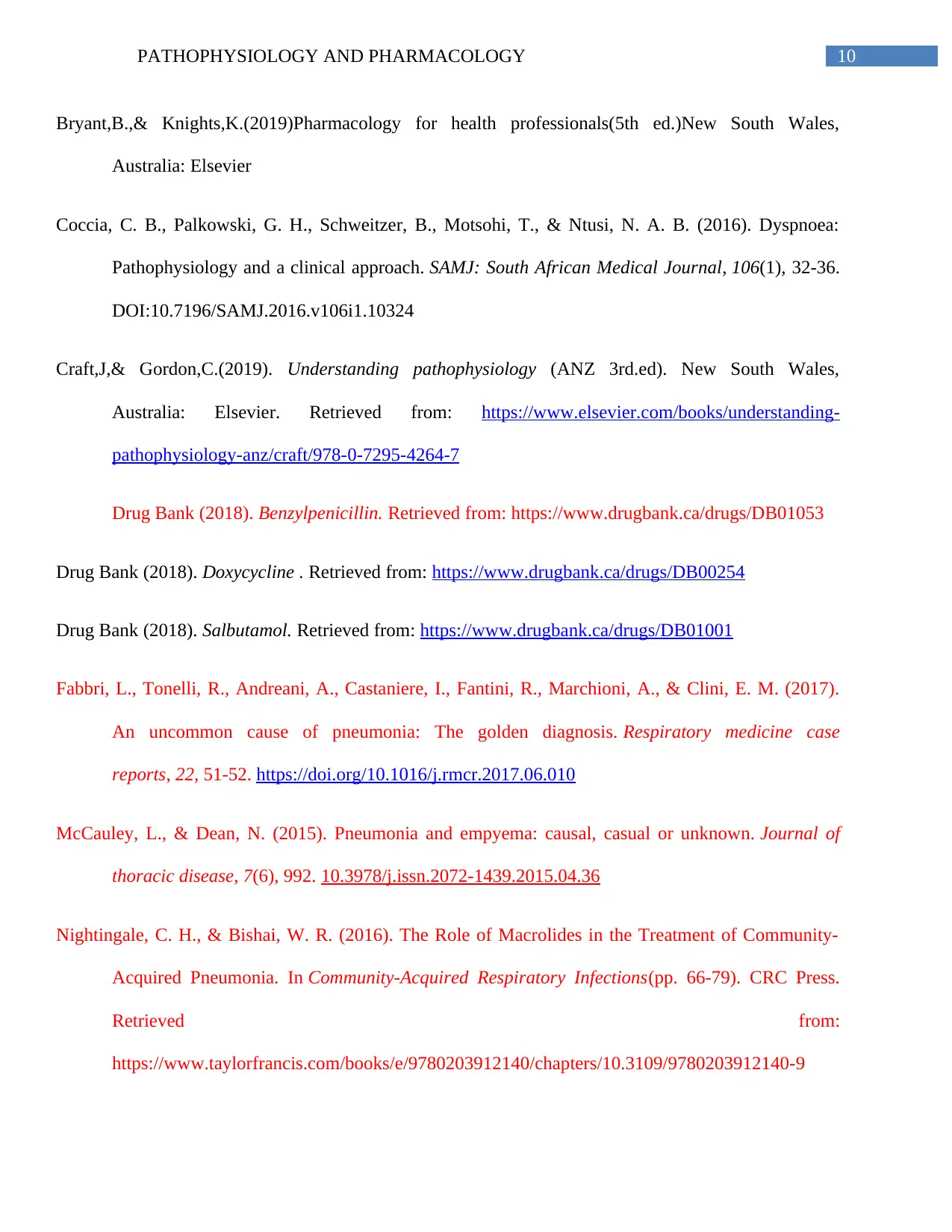
10PATHOPHYSIOLOGY AND PHARMACOLOGY
Bryant,B.,& Knights,K.(2019)Pharmacology for health professionals(5th ed.)New South Wales,
Australia: Elsevier
Coccia, C. B., Palkowski, G. H., Schweitzer, B., Motsohi, T., & Ntusi, N. A. B. (2016). Dyspnoea:
Pathophysiology and a clinical approach. SAMJ: South African Medical Journal, 106(1), 32-36.
DOI:10.7196/SAMJ.2016.v106i1.10324
Craft,J,& Gordon,C.(2019). Understanding pathophysiology (ANZ 3rd.ed). New South Wales,
Australia: Elsevier. Retrieved from: https://www.elsevier.com/books/understanding-
pathophysiology-anz/craft/978-0-7295-4264-7
Drug Bank (2018). Benzylpenicillin. Retrieved from: https://www.drugbank.ca/drugs/DB01053
Drug Bank (2018). Doxycycline . Retrieved from: https://www.drugbank.ca/drugs/DB00254
Drug Bank (2018). Salbutamol. Retrieved from: https://www.drugbank.ca/drugs/DB01001
Fabbri, L., Tonelli, R., Andreani, A., Castaniere, I., Fantini, R., Marchioni, A., & Clini, E. M. (2017).
An uncommon cause of pneumonia: The golden diagnosis. Respiratory medicine case
reports, 22, 51-52. https://doi.org/10.1016/j.rmcr.2017.06.010
McCauley, L., & Dean, N. (2015). Pneumonia and empyema: causal, casual or unknown. Journal of
thoracic disease, 7(6), 992. 10.3978/j.issn.2072-1439.2015.04.36
Nightingale, C. H., & Bishai, W. R. (2016). The Role of Macrolides in the Treatment of Community-
Acquired Pneumonia. In Community-Acquired Respiratory Infections(pp. 66-79). CRC Press.
Retrieved from:
https://www.taylorfrancis.com/books/e/9780203912140/chapters/10.3109/9780203912140-9
Bryant,B.,& Knights,K.(2019)Pharmacology for health professionals(5th ed.)New South Wales,
Australia: Elsevier
Coccia, C. B., Palkowski, G. H., Schweitzer, B., Motsohi, T., & Ntusi, N. A. B. (2016). Dyspnoea:
Pathophysiology and a clinical approach. SAMJ: South African Medical Journal, 106(1), 32-36.
DOI:10.7196/SAMJ.2016.v106i1.10324
Craft,J,& Gordon,C.(2019). Understanding pathophysiology (ANZ 3rd.ed). New South Wales,
Australia: Elsevier. Retrieved from: https://www.elsevier.com/books/understanding-
pathophysiology-anz/craft/978-0-7295-4264-7
Drug Bank (2018). Benzylpenicillin. Retrieved from: https://www.drugbank.ca/drugs/DB01053
Drug Bank (2018). Doxycycline . Retrieved from: https://www.drugbank.ca/drugs/DB00254
Drug Bank (2018). Salbutamol. Retrieved from: https://www.drugbank.ca/drugs/DB01001
Fabbri, L., Tonelli, R., Andreani, A., Castaniere, I., Fantini, R., Marchioni, A., & Clini, E. M. (2017).
An uncommon cause of pneumonia: The golden diagnosis. Respiratory medicine case
reports, 22, 51-52. https://doi.org/10.1016/j.rmcr.2017.06.010
McCauley, L., & Dean, N. (2015). Pneumonia and empyema: causal, casual or unknown. Journal of
thoracic disease, 7(6), 992. 10.3978/j.issn.2072-1439.2015.04.36
Nightingale, C. H., & Bishai, W. R. (2016). The Role of Macrolides in the Treatment of Community-
Acquired Pneumonia. In Community-Acquired Respiratory Infections(pp. 66-79). CRC Press.
Retrieved from:
https://www.taylorfrancis.com/books/e/9780203912140/chapters/10.3109/9780203912140-9
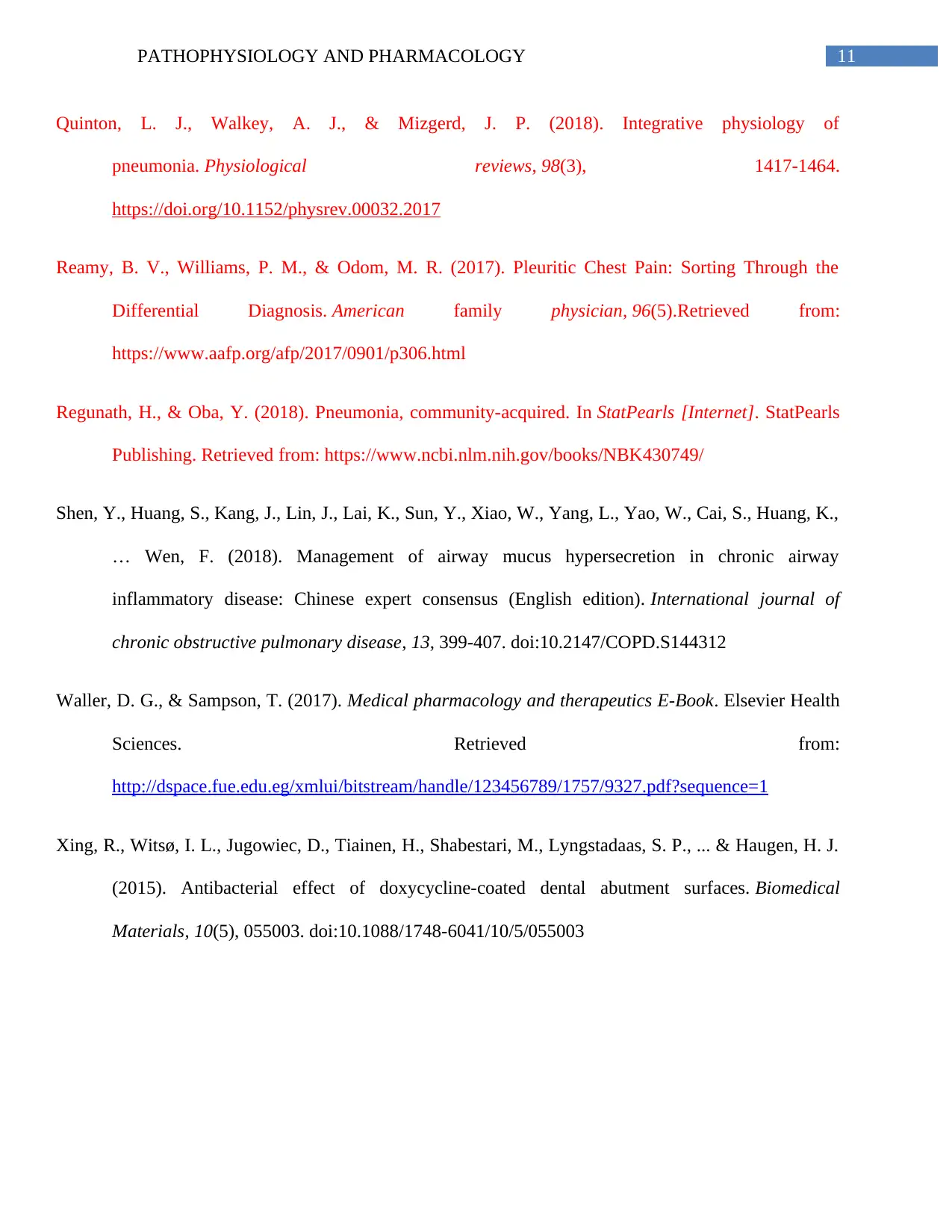
11PATHOPHYSIOLOGY AND PHARMACOLOGY
Quinton, L. J., Walkey, A. J., & Mizgerd, J. P. (2018). Integrative physiology of
pneumonia. Physiological reviews, 98(3), 1417-1464.
https://doi.org/10.1152/physrev.00032.2017
Reamy, B. V., Williams, P. M., & Odom, M. R. (2017). Pleuritic Chest Pain: Sorting Through the
Differential Diagnosis. American family physician, 96(5).Retrieved from:
https://www.aafp.org/afp/2017/0901/p306.html
Regunath, H., & Oba, Y. (2018). Pneumonia, community-acquired. In StatPearls [Internet]. StatPearls
Publishing. Retrieved from: https://www.ncbi.nlm.nih.gov/books/NBK430749/
Shen, Y., Huang, S., Kang, J., Lin, J., Lai, K., Sun, Y., Xiao, W., Yang, L., Yao, W., Cai, S., Huang, K.,
… Wen, F. (2018). Management of airway mucus hypersecretion in chronic airway
inflammatory disease: Chinese expert consensus (English edition). International journal of
chronic obstructive pulmonary disease, 13, 399-407. doi:10.2147/COPD.S144312
Waller, D. G., & Sampson, T. (2017). Medical pharmacology and therapeutics E-Book. Elsevier Health
Sciences. Retrieved from:
http://dspace.fue.edu.eg/xmlui/bitstream/handle/123456789/1757/9327.pdf?sequence=1
Xing, R., Witsø, I. L., Jugowiec, D., Tiainen, H., Shabestari, M., Lyngstadaas, S. P., ... & Haugen, H. J.
(2015). Antibacterial effect of doxycycline-coated dental abutment surfaces. Biomedical
Materials, 10(5), 055003. doi:10.1088/1748-6041/10/5/055003
Quinton, L. J., Walkey, A. J., & Mizgerd, J. P. (2018). Integrative physiology of
pneumonia. Physiological reviews, 98(3), 1417-1464.
https://doi.org/10.1152/physrev.00032.2017
Reamy, B. V., Williams, P. M., & Odom, M. R. (2017). Pleuritic Chest Pain: Sorting Through the
Differential Diagnosis. American family physician, 96(5).Retrieved from:
https://www.aafp.org/afp/2017/0901/p306.html
Regunath, H., & Oba, Y. (2018). Pneumonia, community-acquired. In StatPearls [Internet]. StatPearls
Publishing. Retrieved from: https://www.ncbi.nlm.nih.gov/books/NBK430749/
Shen, Y., Huang, S., Kang, J., Lin, J., Lai, K., Sun, Y., Xiao, W., Yang, L., Yao, W., Cai, S., Huang, K.,
… Wen, F. (2018). Management of airway mucus hypersecretion in chronic airway
inflammatory disease: Chinese expert consensus (English edition). International journal of
chronic obstructive pulmonary disease, 13, 399-407. doi:10.2147/COPD.S144312
Waller, D. G., & Sampson, T. (2017). Medical pharmacology and therapeutics E-Book. Elsevier Health
Sciences. Retrieved from:
http://dspace.fue.edu.eg/xmlui/bitstream/handle/123456789/1757/9327.pdf?sequence=1
Xing, R., Witsø, I. L., Jugowiec, D., Tiainen, H., Shabestari, M., Lyngstadaas, S. P., ... & Haugen, H. J.
(2015). Antibacterial effect of doxycycline-coated dental abutment surfaces. Biomedical
Materials, 10(5), 055003. doi:10.1088/1748-6041/10/5/055003
1 out of 12
Your All-in-One AI-Powered Toolkit for Academic Success.
+13062052269
info@desklib.com
Available 24*7 on WhatsApp / Email
![[object Object]](/_next/static/media/star-bottom.7253800d.svg)
Unlock your academic potential
© 2024 | Zucol Services PVT LTD | All rights reserved.





